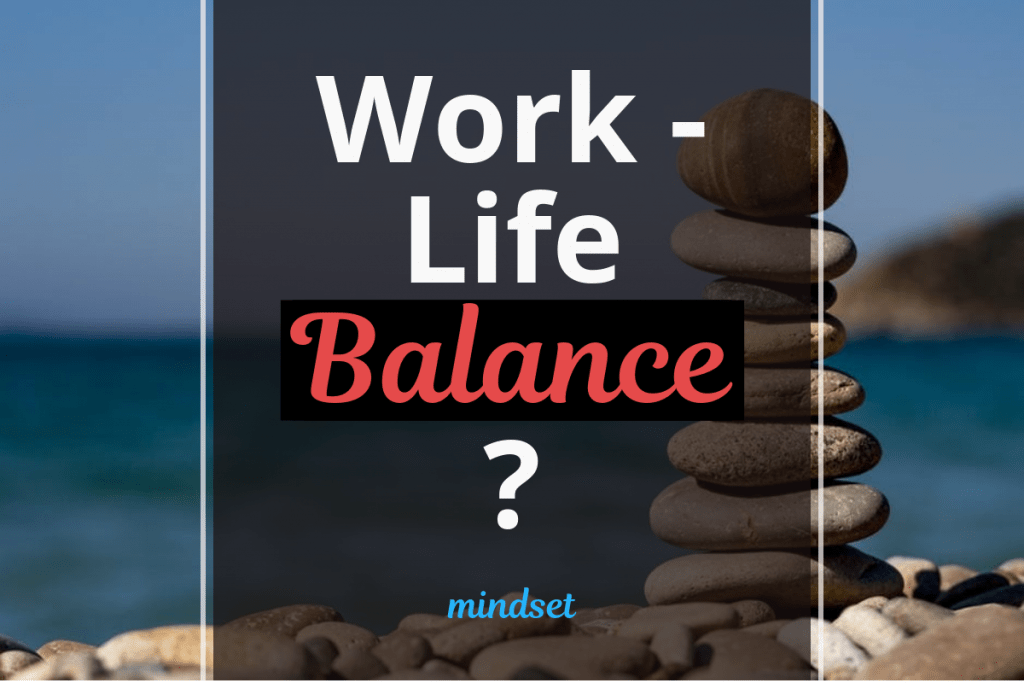🖊 This article was last updated on January 27, 2022
We wear many hats: parent, spouse, child, friend, manager, employee, side hustler, entrepreneur. We’d love to have enough time to be all these and sneak in enough time to take care of ourselves too.
But let’s get real. More often than not, we can’t figure out how to put everything and everyone in our calendar.
We may be thinking: “If only I can get better at work-life balance, then I can have it all.”
We often fail at achieving that elusive work-life balance and think it’s because of our poor time management skills. While this can be a contributing factor, we may have misconceptions about what work-life balance is, and are therefore aiming for impossible standards.
Read on to discover the 4 myths about “work-life balance” and why it’s not achievable for most of us.
Work-Life Balance Myths

- The term “work-life balance” implies a perfect balance between “work” and “life.” It suggests that we must divide our time, energy, and attention equally among our career goals, family, friends, own businesses, self-care, and hobbies.
- It implies a fixed state of life, where everything remains the same. But the truth is, our priorities change based on our life season and circumstances. In college, we may have had less time for our families and focused more on our studies and new friends. As we mature, our dreams change, and we may decide to let go of some things so we can focus on the aspects we value most.
- Third, the term “work-life balance” suggests that work and life are mutually exclusive: Working is not part of living. But people who have found meaning in their work will disagree with this. Some of us are even having so much fun at work that we no longer have clear-cut distinctions between “working” and “playing.”
- Work-life balance implies that there is always a trade-off: The time we put into work robs us of time we can invest in our relationships. Or leaving the office on time makes us less productive.
There may be some truth to the last one, especially if you are clocking in 60-hour workweeks. You may be missing too many family dinners or cutting back on much-needed sleep.
But your work also allows you to provide for your family and fund your dreams; therefore, it supports your relationship and financial goals. Also, the time you spend away from work doesn’t necessarily make you less productive. Studies show it can actually help you recharge so you can feel more relaxed and be more focused at work.
But if work-life balance is a myth, what else is there to aim for?
Work-life harmony
With work-life harmony, we start looking at different parts of our lives as supporting, instead of opposing, each other. Just like how carefully chosen notes, played together, can produce a musical masterpiece, we need to choose which activities to keep, add, or delete (if they don’t blend well with our lives).
Amazon CEO Jeff Bezos uses the framework of work-life harmony to step up his productivity and performance. As he tells Thrive Global: “Balance tends to imply a strict tradeoff. In fact, if I’m happy at work, I’m better at home — a better husband and a better father. And if I’m happy at home, I come into work more energized — a better employee and a better colleague.”
Below are some tips to help you create work-life harmony.
Having work-life harmony

1. Give up the idea that you should give equal time to every aspect of your life
For example, if you are building a business while working a full-time job, know that you will be spending less time going out with friends or watching your favorite games.
There will be seasons in your life when you’d spend more time on your career, or choose to spend more time with your kids. But while we cannot give equal amounts of time to each critical aspect of our lives, we can still find time for these items and put them in our schedules.
2. Identify the areas that are important to you, then create goals and plan activities for each
In my article on setting GROWTH goals, I talk about the importance of starting with a grand vision (having a long-term goal) and knowing your “why”, then planning how to achieve goals.
Once you have identified your most important goals, plot these activities in your calendar. Is it your child’s graduation you wouldn’t want to miss? Your anniversary? Date nights? By putting them in your calendar first, you can be sure that your most important goals will not be at the mercy of urgent yet less important activities.
Former first lady Michelle Obama used this strategy to manage their family’s busy schedule long before her husband became president. At the start of every year, they looked at their personal commitments and scheduled these first. She shared: “We put potlucks in there, we put date nights in there, I put my workouts, we put our vacations on the calendar first, we put sports things and summers. We planned that out first, and then what was left would be left for work.”
3. Prioritize
Once you have identified your most important goals, apply the Pareto Principle to trim down your to-do list. Ask yourself: “Which 20 percent of my tasks will most likely have the biggest impact on my business?”
Instead of making it a goal to check off many (meaningless) tasks, focus on key decisions and outputs. As Jeff Bezos says, “making a small number of key decisions well is more important than making a large number of decisions.”
4. Be fully present
Work-life harmony is not just about smoothly weaving into our schedule all that’s important to us. It’s about living fully by being present to the people and activities we value. So if you have dedicated Saturdays to bond with your loved ones after a week-long trip, gift them with your full attention. Resist the temptation to read your work emails. Make sure that the people you love know you love them, and that they do not feel like they are at the bottom of your priority list.
Conclusion
As we deal with the pressure of growing our business, nurturing our relationships, and maybe even working a full-time job, we will find it impossible to give equal time and attention to every important aspect of our lives. Pursuing work-life harmony helps us put the most important things first and hack away at those which are less important.
This doesn’t mean we will always be in control of our schedule though. Once in a while, we might break a promise we made to ourselves. We might have to work more hours during our companies’ busy season for example.

We will never be able to balance things perfectly and that’s okay. Gary Vaynerchuk, in an article on time management, shares that while he holds himself accountable, he does not judge himself when he messes up.
Why not do the same? Next time you feel like a failure for prioritizing the wrong things (for the nth time), stop criticizing yourself. Look at what you can do better. Then do exactly that.
Now it’s your turn. What’s your take on work-life balance or work-life harmony? What habits/strategies work for you? I look forward to reading your comments!
- These Black Friday deals will skyrocket your productivity (2021 edition) - November 11, 2021
- How to Stay Productive as a Digital Nomad - December 23, 2019
- When is the right time to outsource? - December 3, 2019


Such a good read! Great tips to start the new year (or to start any mindset change).
Hi Dari,
I’m glad you liked the article, although I think any time of year is a great time to start with a mindset shift 🙂
Have a great day,
Kristof